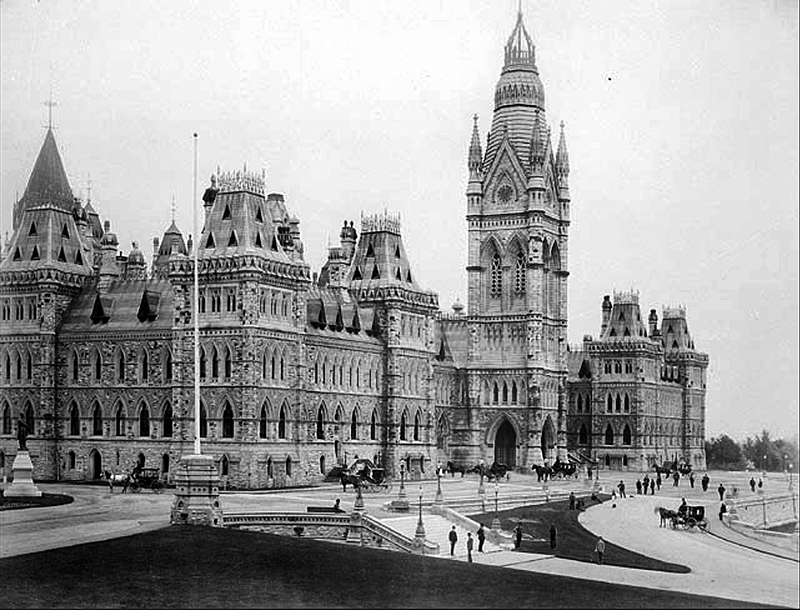
Centre Block’s predecessor, with its ornate 55-metre Victoria Tower, was an internationally recognized symbol of Canada.[Library and Archives Canada]
Within minutes the entire room was ablaze and instead of smothering the fire, the extinguisher scattered the embers, first igniting newspapers hanging from dowels along the walls, then nearby magazines and a collection of 20,000 books, some dating back more than a century.
In just a few hours, Canada’s seat of power, considered one of the finest examples of Gothic Revival architecture in the British Empire, was a pile of smouldering ruins.
And seven people were dead.
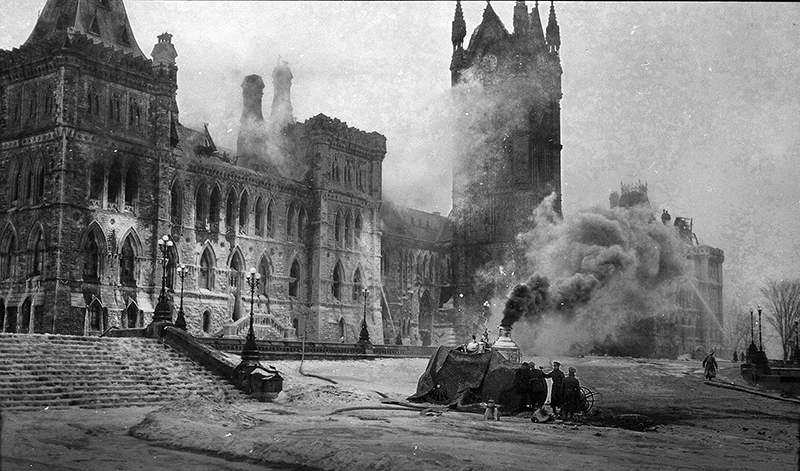
Steam-driven pumps drawing water from the Ottawa River and city water mains could barely contain the blaze that gutted the building on the night of Feb. 3 and 4, 1916.[Library and Archives Canada]
During the process, librarian Alpheus Todd had insisted that the Library of Parliament be constructed of non-combustible stone and be separated from the main building by a long corridor ending in iron doors, having survived a fire.
The library, grounds and Queen’s Gates completed the project on Parliament Hill in 1876.
The ornate 76-metre-high Victoria Tower rose above a magnificent, sandstone-faced four-storey structure of about 10,200 square metres. It housed the Commons and Senate, 170 offices, a picture gallery, 85 committee rooms, reading rooms, office space and an apartment for the Speaker of the House.
The Parliament Building’s stately facade faced downtown Ottawa, but from the river, its towers, spires and buttresses were reminiscent of European castles.
In just a few hours, Canada’s seat of power was a pile of smouldering ruins.
In 1916, the city was in the throes of one of its coldest winters when the fire alarm was sounded at 8:57 p.m. It took three minutes for the nearest firefighters to arrive.
But when they did, the building was already a lost cause. The wood covered with varnish and shellac in its interior acted as an accelerant and flames raced down corridors and into rooms throughout the building.
The 20 parliamentarians on the floor of the House barely had time to escape. Prime Minister Robert Borden and his secretary got out practically on hands and knees. Members of the press in the gallery above were engulfed by thick black smoke as they made their way down a winding staircase to exit.
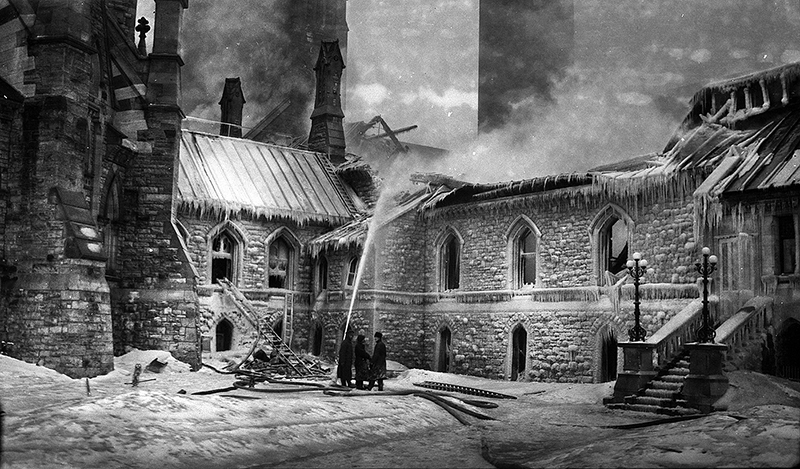
Fire crews drenched the building with water to prevent flames spreading to the Library of Parliament. [Library and Archives Canada]
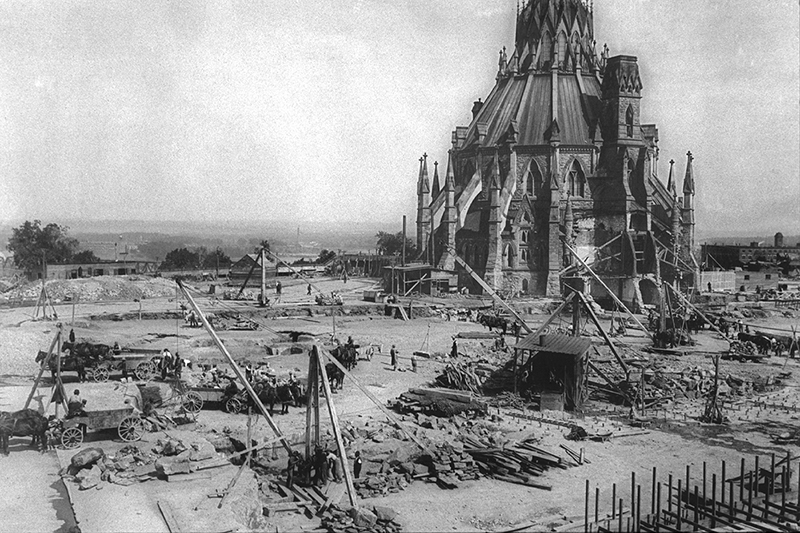
The Library of Parliament was the only part of the building to survive.[ Library and Archives Canada]
The Speaker raced from his office to lead his children and wife, who had three women visitors, from his apartment to safety. The guests went back for their furs and two died of smoke inhalation. The third woman dangled from a window for 10 minutes before dropping more than 12 metres into a fireman’s net.
The guests went back for their furs and two died of smoke inhalation.
A wall of flames blocked the exit for two MPs in the lavatory, so they knotted towels together, dropped them through a window and climbed down—still, they had to jump the final six metres.
A police officer, post office employee and maintenance worker and his nephew were helping people escape when they were crushed by a collapsing ventilation tower. A Nova Scotian MP and an assistant clerk of the House perished when overcome by smoke and heat on the upper floors of the building.
Meanwhile, the heroes of the moment were hard at work.
Library clerk Michael MacCormac heaved the iron doors of the Library of Parliament closed seconds before flames reached the end of the corridor outside it. Its stone structure and distance from the main building ensured its survival. After the smoke settled, the library was the only remaining part of the original buildings.
Lieutenant-Colonel Ernest Chambers, Gentleman Usher of the Black Rod, organized a brigade to save some treasures, particularly paintings and portraits.
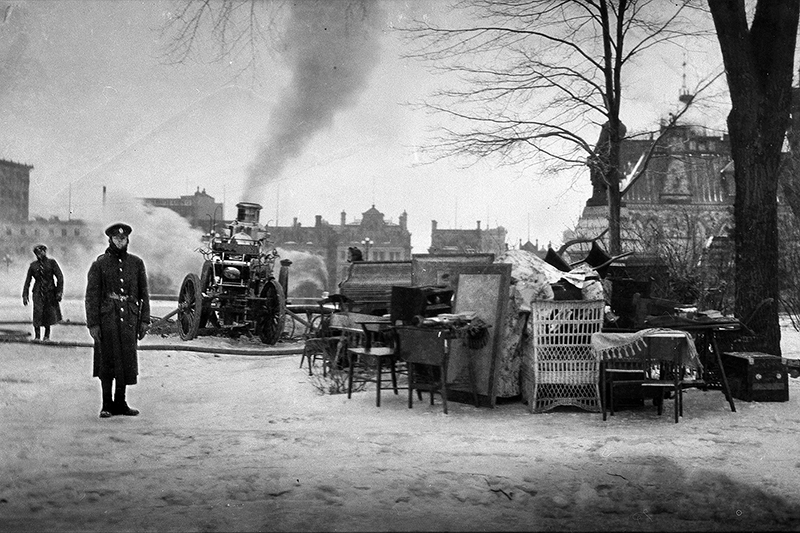
Volunteers piled furniture and artifacts rescued from the Senate on the Parliament Hill grounds.[Library and Archives Canada]
The portrait of Queen Victoria, which before recent renovations was hanging in the foyer of the Senate in the Centre Block, was saved from flames for a fourth time, ironically by A.H. Todd, nephew of one of its previous rescuers, Alpheus Todd.
After the smoke settled, the library was the only remaining part of the original buildings.
On Feb. 4, Ottawans gathered around the ruins, ice-covered but still smouldering in the frigid air.
It was midway through the First World War and onlookers couldn’t help but speculate that enemy saboteurs were at fault. People with foreign accents were arrested and questioned, but a Royal Commission laid the blame on an electric fault, or perhaps cigar smokers, who frequented the reading room and often ignored the prohibition on smoking.
The dry wood panelling, varnish and shellac, mounds of paper and shelves of books were “the most perfect arrangement ever devised for a sudden and successful conflagration,” said the commission.
That arrangement would not happen again and Borden promised “an even grander pile will rise, Phoenix-like from the ashes.”
The edifice that rose from the ashes was finished as a memorial to Canadians who fought in the First World War. It is in Modern Gothic Revival style, less ornate, but much more fireproof due to its limestone interior walls and marble floors. Its stained-glass windows, murals, frescoes and architectural sculptures ensure it’s equally impressive.
Reconstruction began in the summer of 1916 and, still unfinished, it opened in February 1920.
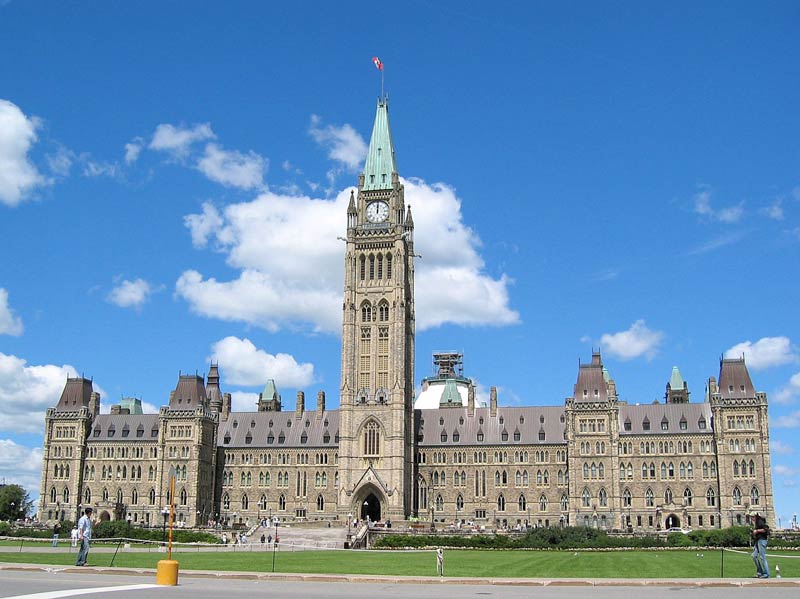
The Victoria Tower was replaced by the Peace Tower, which was dedicated on July 1, 1927. [Wikipedia]
The Parliament Buildings were closed in 2018 for a $5 billion restoration project. The interior of the Centre Block has been carefully disassembled and legislators have been moved to other locations while a century’s worth of damage to the substructure is repaired, hazardous substances removed and antiquated plumbing, heating and electrical systems are brought up to modern codes.
It is set to be completed in 2030-31.
Advertisement





















